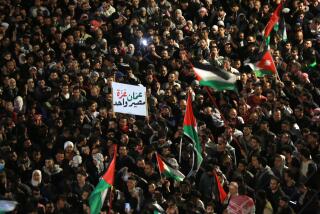Elation and impatience in Alexandria, Egypt
When Egypt’s anti-government protests began, Mohamad Ramadan Ibrahim headed south to Cairo.
Even though thousands of people in the country’s second-largest city were protesting daily outside the Qaid Ibrahim Mosque, Ibrahim wanted to be in the center of it. He spent 17 days sleeping, eating and bonding with other demonstrators in Tahrir Square, staying even after a rubber bullet hit him near the eye on Jan. 28.
But at dawn Saturday, he found a stranger near the square to give him a ride home.
“I want to celebrate with my family here in Alexandria,” the 40-year-old taxi driver said.
By early afternoon, he and his wife were at the mosque, a white patch of gauze covering his eye, and strolling the street like an injured soldier at a homecoming.
He joined the hundreds who came to the mosque throughout the day, unwilling to end the celebration over President Hosni Mubarak’s resignation.
When the news broke Friday, the crowd gave prayers of thanks in the streets. But on Saturday, the busy thoroughfare about 100 feet from the Mediterranean Sea was a confluence of those looking back, those still in the moment and those wanting to move forward.
The mosque and the imam who used to preach there had long been a symbol of resistance to Mubarak. Sheikh Ahmad El Mahalawy was banned from preaching more than 15 years ago because he spoke pointedly about the corruption in government, noted Salim Shabaan Saadani, who had come to the gathering holding his malnourished 2-year-old son.
El Mahalawy recently spoke from the mosque’s pulpit for the first time since he was banned, Saadani said. The congregants were shocked. Some had thought he was dead. The 86-year-old sheikh spoke about freedom and what lies ahead, Saadani said.
On Saturday, as the flag-waving throngs grew and spilled onto neighboring streets, many could not enjoy it without bitterness about what they had been through.
Conversations about the previous day’s events quickly turned to the slights they had suffered under Mubarak.
Men pulled out hospital bills they could not afford to pay, citing them as evidence that the country didn’t care about its people. Others pulled out jail-release papers, listing their political crimes. Still others complained of the indignities of paying bribes and of police beatings.
As the day went on and the street in front of the mosque filled, vehicles trying to get through moved in starts and stops. People waving flags stepped in front of them. Motorists honked, but it wasn’t always clear if it was in celebration or irritation.
Eventually, the street was completely blocked.
Seyed Mohamad Ahmad, 45, pulled onto the street in his taxi and was faced with a veritable parking lot of people and vehicles. He tried moving forward but people waved him back.
“The time for celebration is done, the time for work is now,” he said, turning around so he could back down the street slowly. He quoted Mubarak’s vice president, Omar Suleiman: “We have to get back to work.”
Ahmad, a business college graduate, joined the protests in the first few days days but eventually had to get back behind the wheel.
“As you know, those whose money comes from day-to-day work can’t stay away for too long,” he said.
Hilal Marzoyk, 61, came to the mosque for noon prayers and stood for a few minutes watching those cheering in the street. The time for street demonstrations was over, he said, fiddling with a cell phone between gnarled fingertips.
“Hosni Mubarak is past, we should think about what’s next, what’s going to happen and what’s coming,” said Marzoyk, a retired government employee who works in real estate. “Life needs to go on, and go back to rebuild what was destroyed.”
More to Read
Start your day right
Sign up for Essential California for news, features and recommendations from the L.A. Times and beyond in your inbox six days a week.
You may occasionally receive promotional content from the Los Angeles Times.







